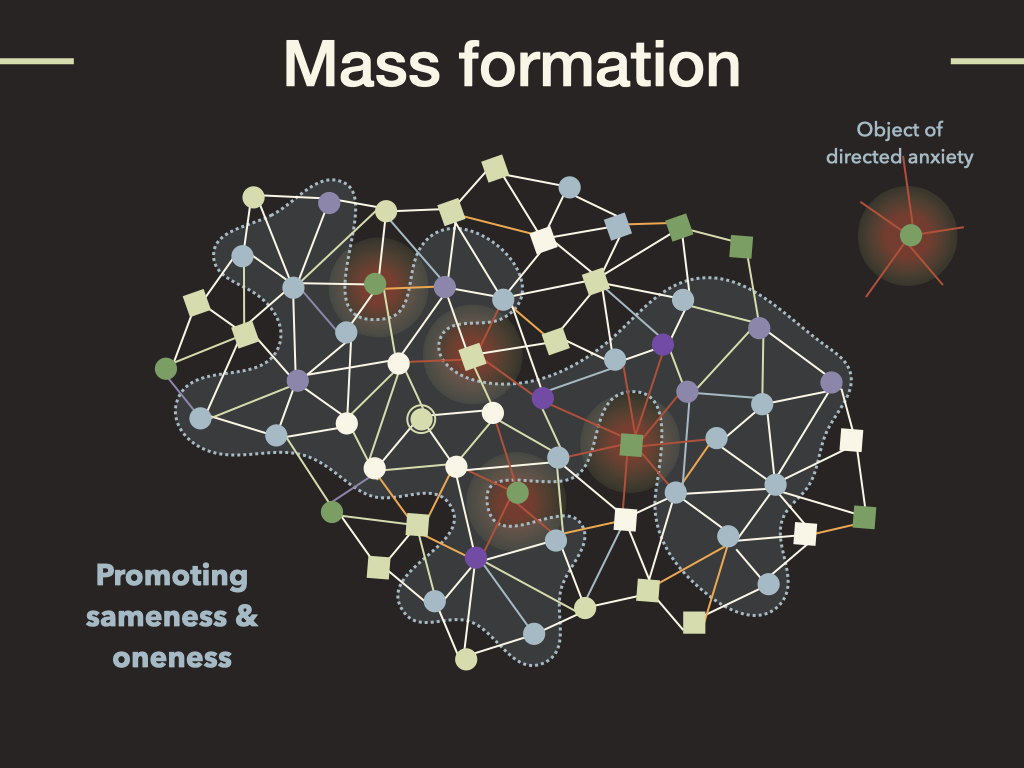
This is an accessible, but not simplified, text in which derive the features of mass formation and the associated mass cognition from basic features of life.
We show it predicts the properties of authoritarianism and canceling very well.

In this analysis we derive the features of mass formation and the associated mass cognition (authoritarianism) from the basic features of life. We do this from the theoretical perspective of core cognition: the hypothesized cognition shared by all of life.
Only a small part of this text concerns humans. Most of it pertains to all living agents. A key feature is of agents is agency: the ability to self-maintain existence.
Core cognition describes the basic requirements for the selection of situationally appropriate behavior. Selecting situationally appropriate behavior is what all living agents do, all the time.
Agents differ in state, skills, and context and they influence both each other and the habitat via their behaviors. Behavior selection is a continual process and is unique for each agent.
In this presentation we oppose two modes of being – coping an co-creation – as a caricature of the actual continual and mostly constructive, interplay between these modes.
However, mass formation emerges as a habitat wide dominance of coping through the suppression of co-creation in situations were agents are inadequate and respond by curtailing difference. In this extreme, it makes sense to temporarily dispense of nuance.
Coping and co-creation are balancing like yin and yang. Co-creation promotes diversity, complexity, novelty, and connectedness. Coping balances this by providing structure, predictability, utility, and focus. A productive interplay keeps the habitat vibrant and stable and allows its inhabitants to develop the skills to flourish.
This presentation focuses on what happens when habitat complexity exceeds the coping capacity of most inhabitants. The main text focusses on the introduction and description of phenomena. The footnotes provide literature references1 and illustrative comments2.
We start with some basics of core cognition.

Life can be described as “being by doing”: (living) agents exists because they act in ways that allow them to avoid danger, low viability, and death. Individuals always aim to be and remain as safe and viable (far from death) as possible. They strive to be and remain well.
Cognition for survival and problem solving differs from cognition for flourishing and problem prevention. Cognition for survival and problem solving has particular start-states such as problem or threat and end-states: a threat that has been dealt with or a problem solved. Cognition for flourishing and problem prevention does not have particular start- or end-states and ideally continues indefinitely as a goalless progression of favorable states3.
We call cognition for survival and problem solving “coping” and cognition for flourishing and problem prevention “co-creation”. In case of life success, co-creation is the default and coping is only a temporary fallback intended to restore safety after co-creation failed.
We refer to co-creation adequacy if the agent succeeds in preventing most problems. It exhibits coping adequacy if it solves problems quickly and effectively.
Conversely co-creation inadequacy entails that agents are instrumental in creating their own problems states. And coping inadequacy if agents fail to end problems effectively.
In particular, if the coping mode of behavior leads to more or new problems or continued danger, it remains activated: a coping trap, where coping has become the default. Individuals in this state may never learn to become adequate co-creators. Life success requires that co-creation became the default mode of cognition.
Living agents learn a lot from copying the behaviors of others. But to become fully autonomous self-directors they need to overcome the limits of social mimicry and following the lead of others. They must learn to trust their own decision-making; until that time they exhibit bounded autonomy. Development from bounded autonomy to full autonomy is central to successful identity development.
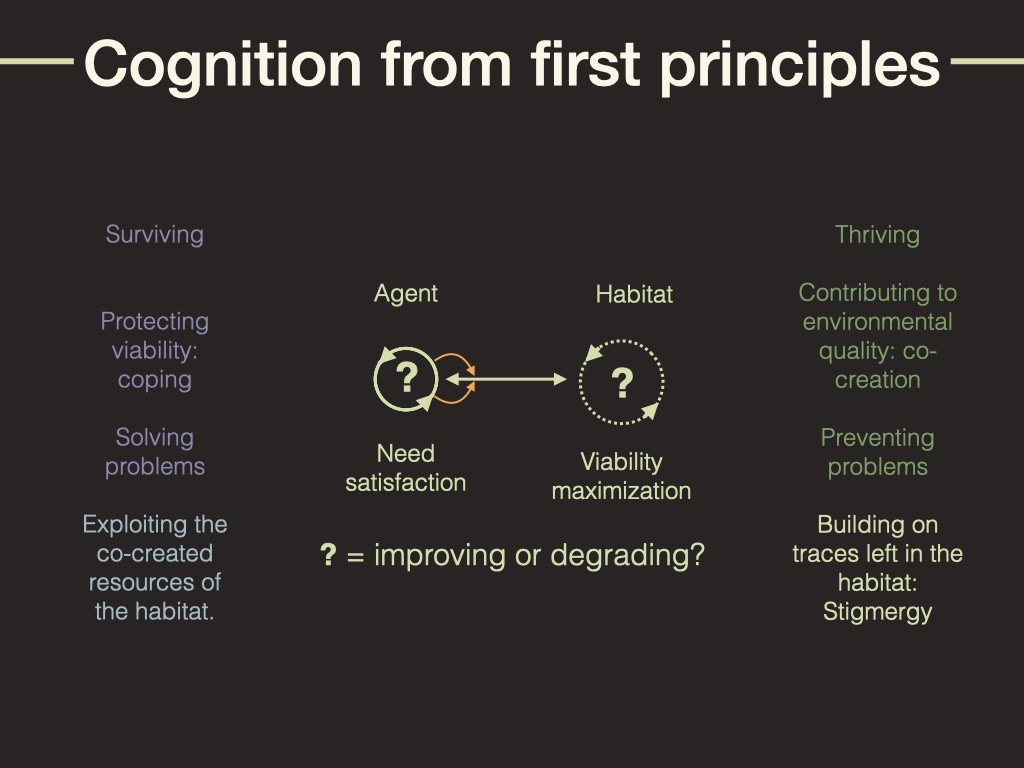
To remain alive agents must protect their viability by satisfying basic needs. But they must also contribute to the viability of their habitat, because all life depends on habitat resources to satisfy short and long term needs.
A surviving agent copes with pressing problems to protect its viability and generally takes more from its environment than it contributes. This is characteristic of coping.
A thriving agent contributes to a habitat in which pressing problems can mostly be avoided and habitat viability is maximized. This is a key feature of co-creation.
Dominant co-creation drove and drives the development of the biosphere. Conversely, dominant coping degrades the environment.
Living agency, or agency for short, is the ability to self-maintain existence. Agency manifests itself as bringing the co-dependance of self on the habitat in the service of self and the habitat. This naturally leads to a network of mutual dependency comprising all in the habitat.
In a self-stabilizing habitat, agents mostly express unforced self-initiated natural behavior that minimizes the occurrence of conflict and problems, and that stabilizes the habitat without ever aiming for particular stable states. Forests and human friendships express this dynamic.
Co-creation and coping successes are both the result of skilled behavior. Skilled co-creation entails furnishing the habitat with broadly constructive traces in a process called stigmergy.
Skilled coping entails the quick and effective resolution of problem states and it also provides the stable structure to benefit optimally from stigmergy.
In isolation, coping tends to utilize and exploit the (stigmergic) resources more than it builds them.

Behavior is skilled when the outcomes of an agent’s activities realize intended benefits. Unskilled behavior realizes unintended outcomes: the agent wastes energy or the behaviors cause harm to self or others.
Skilled agents can predict the pattern of outcomes of their agency and select course of actions with likely favorable outcomes This proves they adequately understand what they are doing.
Unskilled agents are ineffective and might produce unintended adverse outcomes: they insufficiently understand the link between action and outcome. They prove inadequate understanding of their habitat.
Agents who, more often than not, effectively predict the pattern of consequences of their own behaviors learn they can rely on their own predictions and become self-directed. Self-directors have brought their agency under self-control. They can, given their habitat, safely self-decide and can become effective co-creators and autonomous actors.
Self-directors are fully autonomous agents who truly self-maintain their existence (while being embedded in and dependent on a habitat to which they contribute). They prove they generally understand the consequences of their own actions and hence tend to appraise the habitat as safe and full of opportunities. They are mostly co-creating and they themselves are the authority of their life. They exhibit an internal locus of control and are self-optimizing their life. In general they are happy.
Agents who often fail to predict the consequences of their own behaviors live in a world of random outcomes. When they self-decide, they are more often than not confronted with unforeseen, typically negative outcomes that they cannot couple to their own actions.
Since they often cannot rely on their own decision-making to realize intended benefits, they fall back and rely on social mimicry, which externalizes their locus of control.
In general they appraise the habitat as unsafe and problematic. This activates undirected anxiety (associated to the state of the whole habitat, not at something in it), and they are mostly coping.
So depending on the ability to deal with habitat demands, the habitat is either appraised as safe and opportunity filled or as unsafe and problematic4.
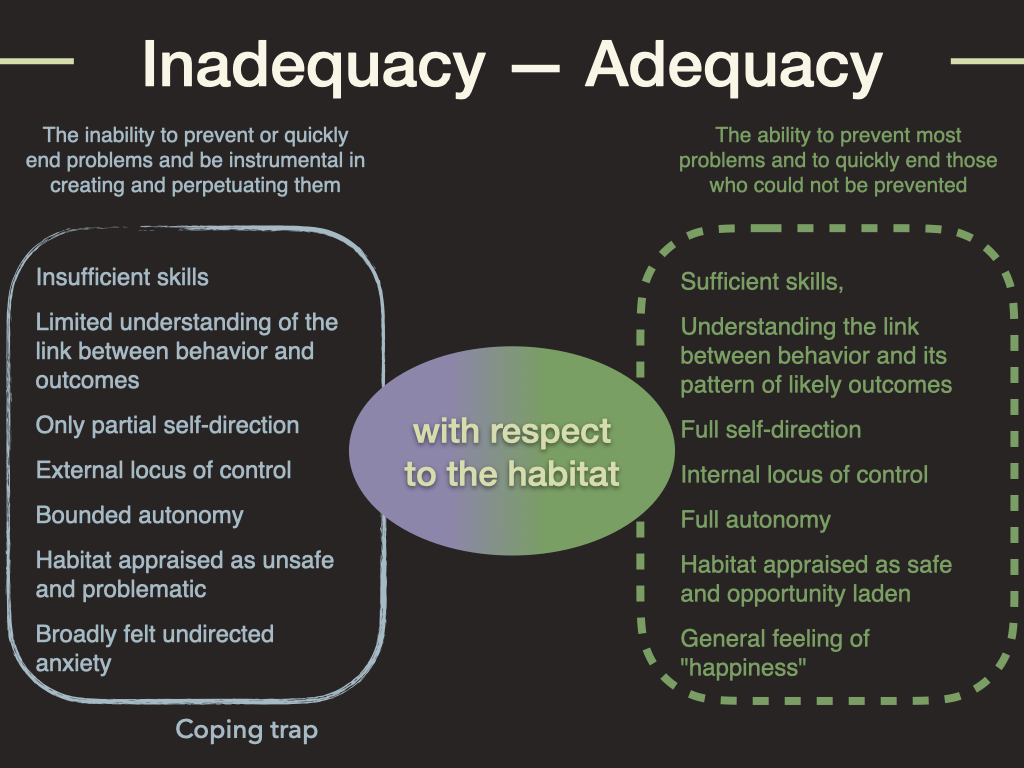
We define adequacy as the proven competence to prevent most problems and to quickly and effectively solve those who could not be prevented. Adequacy is always defined with respect to the habitat. Adequacy in one habitat does not entail adequacy in another.
Adequacy is not some immutable biological fact like species, race, or gender, it depends on a combination of habitat demands, the skill repertoire, a developed sense of realism, appraised safety, and other features that can all to some extend under agentic influence.
Adequacy is an expression, as a pattern of behaviors, of mostly successful real-world interactions. Inadequacy is an expression of an ontology of behavior is response to minimal real-world success5. This text gradually develops some features of these two ontologies6.
The more skills are generalized, they become effective in a wider range of habitats and over longer time-scales. Opportunity exploration and participatory engagement with the habitat, characteristics of co-creation, promote this7.
We refer to adequacy with respect to the habitat as the combination of
In short adequacy is the ability to prevent most problems, and to quickly end those who could not be prevented.
Similarly, we refer to inadequacy with respect to the habitat as the combination of
In short, inadequacy is the inability to prevent or quickly end problems and be instrumental in creating and perpetuating them. We refer to this as a coping trap.
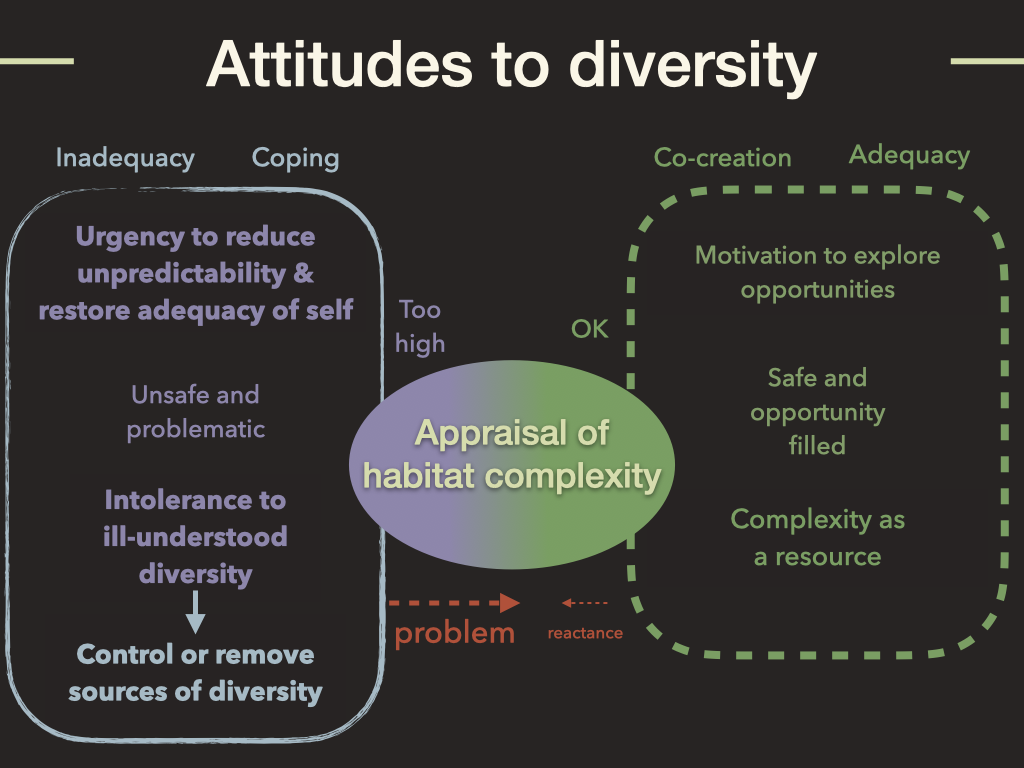
Agents are sources of behavior and the behaviors of many indepently acting agents denotes an explosion of habitat complexity8. Habitat complexity is a challenge for all agents, but most to the least skilled. The appraisal of habitat complexity activates complementary motivations in adequate and inadequate agents.
Adequate agents perceive many affordances and are motivated to explore habitat opportunities and they enhance and protect viability of self and the broader habitat. For the adequate complixity is a resource.
In contrast, inadequacy leads to a focus on the restoration of adequacy. And given the root cause of inadequacy – a lack of understanding between behavior and habitat outcome – this motivates agents to make the habitat more predictable (again). This manifests as an urgency to reduce the unpredictability of the habitat. And since self-directed agent activities are the main source of habitat complexity, inadequacy manifests at intolerance to ill-understood diversity.
The associated behavioral strategy is to focus is on the control or removal of sources of diversity and in particular all co-creation strategies that exceed the inadequate’s scope of understanding.
Typically, the inadequate appraise the most active and effective co-creators as sources of intolerable diversity to be controlled or removed.
The strong urge to curtail and control the behaviors of others is a characteristic of coping dominance9.
Resistance to behavior curtailment is known as reactance10. It is always in response to the curtailment and usually weaker because the adequate typically have plenty of alternatives.
Within the adequate individual, intolerance to diversity promotes self-curtailing of behavioral diversity by complying with some emerging norm. This norm does not need to be optimal or even sensible, it just needs to lead to a less complex habitat.
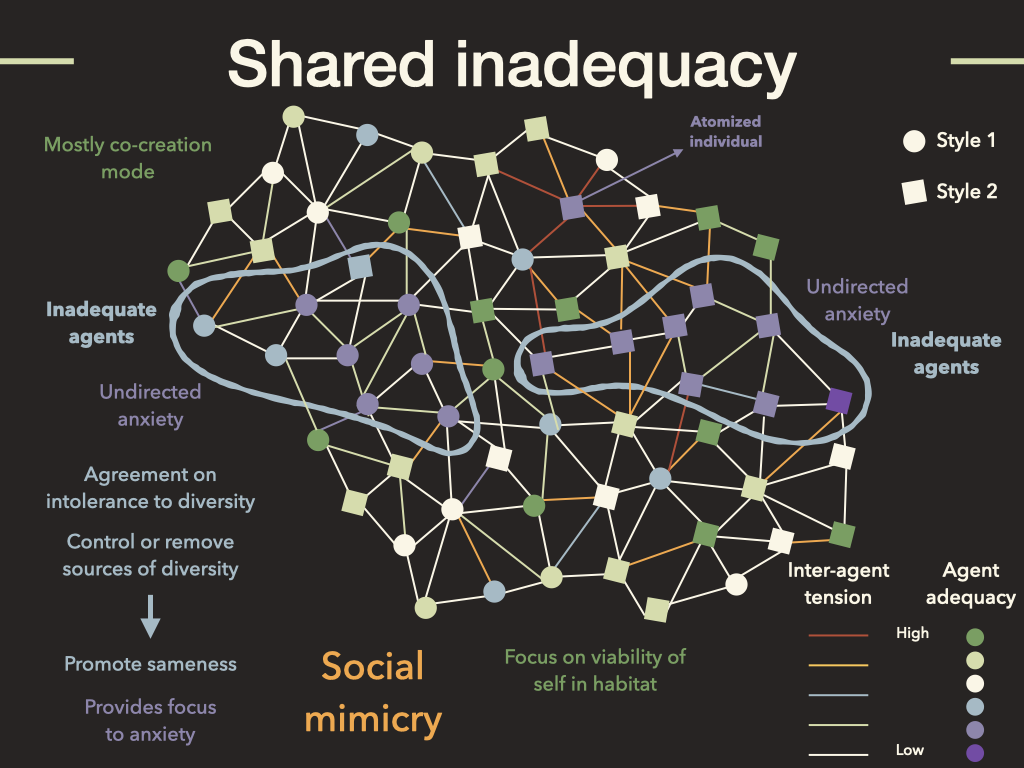
Agents vary not only in adequacy with respect to the habitat. They also form a (never stable and ever-developing) web of relations.
If agents sufficiently understand the link between the actions and the outcome of other agents, inter-agent relations can be tension free and conducive for co-operation. Alternatively, they can be tension laden and conducive for conflict.
In addition, agents differ in interaction styles that we have denoted as style 1 and 2. Given these and other complications, the selection of situationally appropriate behavior is difficult.
Normally, most agents are in a co-creation mode and as such they secure their own viability, while promoting future habitat viability via stigmergy. In doing so, life gradually creates room for more life.
Because co-creating agents focus on viability of self in the habitat, they need to maintain and develop individual adequacy. To a lesser degree they focus on reducing inter-agent tension, because the assumption is that other agents are capable enough to select their own co-creative behavior.
In contrast, inadequate individuals share an urge to reduce habitat complexity to restore or allow individual adequacy. They feel an uneasiness towards the habitat as a whole. This undirected anxiety is so broadly aimed that it is not actionable.
Combined with agent inadequacy and the resulting high risk of harming self and others, this leads to atomized individuals who self-isolate to prevent being victimized by their own adequacy.
However when inadequate agents meet they find the associated reduced behavioral complexity of fellow inadequates attractive. In addition, they share and intolerance to all diversity beyond the scope of understanding.
One possible collaborative strategy is to promote sameness by controlling or removing sources of diversity. It is irrelevant what form of sameness is promoted, it is only relevant that it reduces diversity.
This strategy directs the anxiety and makes it actionable as an urge to increase sameness. In addition the collaboration creates a sense of community and purpose that relieves the social atomization and reduces the appraised randomness (and associated meaninglessness) of the world.
This leads to a shared strategy of social mimicry. Since social mimicry starts local, it gives rise to multiple local clusters of agents that each agree on a local form of sameness.
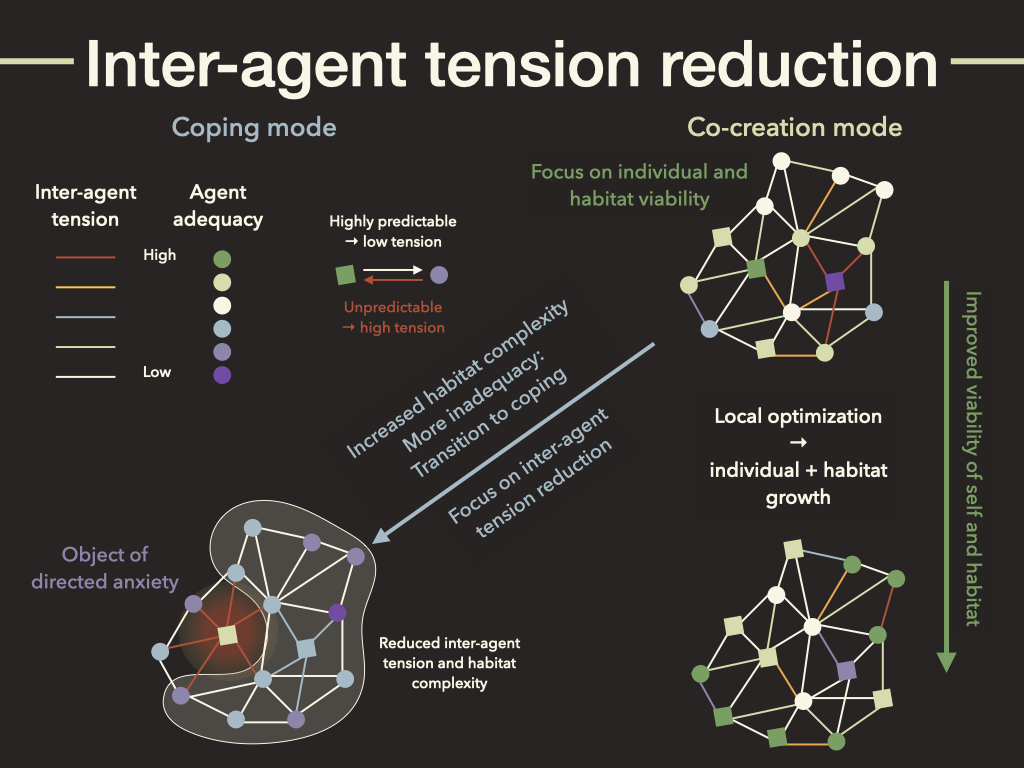
In situations of perceived increased habitat complexity, many agents feel more inadequacy and atomization and transit to the coping mode. This entails a habitat wide strategy shift from self-directed optimization of individual and habitat viability, to strategies focused on reducing habitat diversity and promoting sameness.
In fact, the group-level expression of social mimicry entails a shift to inter-agent tension reduction11. Inter-agent tension is a measure of the unpredictability (perceived randomness) of the behavior of other agents. The more predictable their behavior, the lower the inter-agent tension.
Generally, inadequate agents experience a much higher tension from adequate individuals than vice versa because co-creating agents have higher self-direction and behavioral complexity.
When all group members select from a narrow range of well-known behaviors, within-group tensions are minimized: everyone acts predictably in the eyes of others and behavioral complexity is low12. This effectively reduces the probability of being confronted with one’s inadequacy. But it does not normally improve the habitat.
At some point, groups of inadequate copers “surround” adequate self-directors. As a group they are confronted with a source of ill-understood diversity.
This directs both their intolerance to diversity (a strategy) and free-floating anxiety (which determines urgency) to the source of complexity.

The resulting tension between copers and a minority of co-creators resolves when either the co-creator is coerced to limit its overt behavior down to the complexity of group-level shared behaviors or the co-creator is purged. In short, the options are adapt, leave, or die.
The “leave or die” option manifest a ‘disgust reaction’ in the sense of distancing from a toxic, influence that represents no positive value and deserves no protection.
Sameness promotion leads to the formation of an in-group: a group of agents who share similar adequacy limits, who share an in-group specific set of behaviors and motivations, and who behave in in-group specific ways to minimize the frequency of ill-understood diversity.
Within an in-group, the agents who determine the content of sameness most13, have a special position. They are less confronted with their own inadequacy than other members because they decided on the content of their inadequacy evasion strategies.14 The ability to determine the content of sameness makes them authoritative within the in-group.15
Due to the limits that in-group members impose on each other’s behavior, co-creation becomes very difficult, if not impossible. But high-functioning in-group members16 will be less often confronted with their inadequacy, and thus experience markedly reduced anxiety.
Co-creators do not form in-groups. Instead they form flexible communities of freely cooperating individuals that each promote individual short and long-term viability in the habitat context. For that they need to constantly update life-skills and adequacy through participatory engagement with the habitat.
Ironically, the behaviors that help to increase life-skills and lead to individual and habitat growth are also the source of complexity that the inadequate are intolerant to and try to suppress. This entails that in-groups actively counteract the very influences that can improve their quality of life. It locks them in a coping trap with minimal viability.
This also points to a characteristic difference between copers and co-creators: faced with challenges co-creators skill-up, while copers reduce habitat complexity and skill-down in the service of sameness.
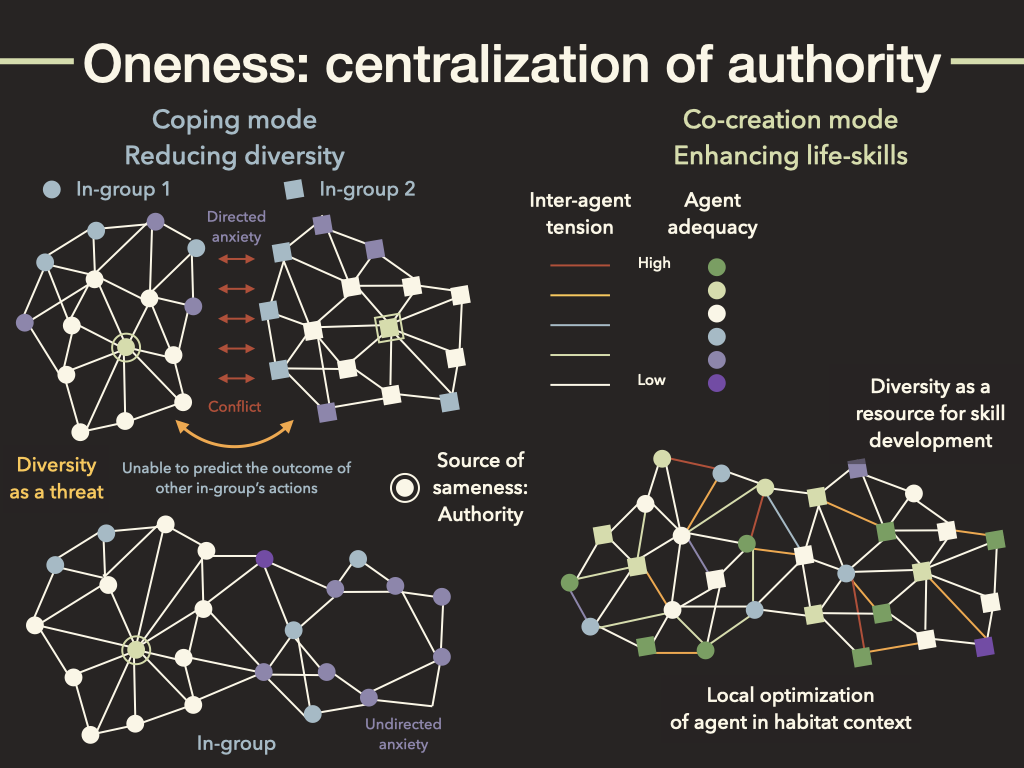
The local promotion of sameness leads to the formation of multiple unequal groups that at some point meet. And that leads to tension between two or more unequal in-groups.
Because in-groups base their cognition on the (arbitrary) content of their own sameness17, they are unable to predict the outcomes of the actions of out-groups. The resulting sense of inadequacy directs the copers broadly felt anxiety and activates an urge to reduce the diversity between the two in-groups.
The tension manifests as an unstable balance between incompatible tendencies to:
The tension, and likely overt conflict, persists as long as the differences persist. At some point in time, possibly after conflict and at great costs of in- and out-groups, enlarged and more stable in-group emerges18.
Once this is established the inadequacy associated anxiety becomes undirected again. (Which entails it is free to be redirected to a new source of ill-understood diversity.)
The enlarged in-group has some sameness style that is now adopted by more agents, who in part needed to change their style. This might be a source of future tension.
The in-group can is only remain stable when it sufficiently suppresses emerging or latent diversity within the in-group. This entails that in-groups always need to invest in in-group diversity curtailment19.
Stable authority needs an infrastructure to implement intolerance to diversity (which may also suppresses the benefits of co-creation)20.
And as long as out-groups exists, even as as slightly different subpopulations of the in-group, its authoritative structures need to be ready and able suppress diversity and enlarge oneness21.
In-groups, as authoritative structures, have a natural tendency to grow. And since this holds even when resources can better be used in other ways. This drain on resources eventually precludes further growth and may be harmful22.
This enriches the role of authority: it is not only a sources of a particular sameness, but it also represents the center of an infrastructure that contributes to the stability of the particular sameness that its inadequate members need to prevent being confronted with their inadequacy.
The previous provides insight in the underlying features of authority. Authority is:
At the same time communities of co-creators within a habitat comprising of more skilled, more diverse, and hence unique individuals hardly feel conflict when confronted with another groups of skilled, diverse and unique individuals. They use the added diversity as a resource to enhance the life-skills necessary for a habitat wide local optimization process of each agent in its environment.

The previous assumed that the mass transition from co-creation to coping just happened. The transition process is actually a complex phenomenon similar to what physics refers to as a phase transition (like from liquid to solid).
Different individuals transit at different moments and probably multiple times to and fro before settling in the coping mode. This depending on how the complexity of the habitat is appraised. The higher the appraised complexity (and the lower the adequacy) , the more likely coping becomes24.
Since coping comes with social mimicry, it leads to a positive feedback loop where more and more inadequate agents adopt a perceived majority style. For individuals this might entail some flip-flopping, before discovering the style of the emergent majority.
This mass formation process adopts, ever quicker, most inadequate agents into growing in-groups. At some transition point these coalesce, seemingly in an instant, to an in-group that spans all corners of the habitat. That is the phase transition due to the habitat wide promotion of a single form of sameness and oneness.
The members of the habitat-spanning, but still sparse25, in-group experience tension wherever adequate self-deciders still co-create and hence stand out on the just-created background of sameness. This directs the in-group’s undirected anxiety to the most visible remaining self-deciders.
The remaining self-deciders stall regression towards further uniformity, simplification, and complete habitat dysfunctioning26. So resistance to emerging sameness, while individually dangerous, is essential to preserve part of the previous habitat well-functioning27.

Mass cognition is a group-level manifestation of coping that starts with not having the skills to
The inadequate live in a world with random outcomes where they do not understand the relation between action and outcomes of self and others.
Being unable to prevent unintended harmful outcomes of behaviors activates an urge restore adequacy through reducing habitat unpredictability. This leads to the promotion of oneness and sameness through control and removal of sources of diversity. Out-groups are given the options adapt, leave, or die.
Similarly, the inability to predict the behaviors of others activates an urge to curtail and control their behaviors. Again this leads to the options adapt, leave, or die.
The overall strategy of mass cognition can be summarized as: the exclusion of all diversity activating agentic inadequacy.
This control strategy effectively aims to reduce an unconstrained open world to a controlled closed world that excludes all that freaks out the inadequate[^Safe]. And that is why it gains broad support among the inadequate.
Even during a mass formation event there is still a minority of adequate agents who persist in co-creation strategies, albeit very much curtailed.
For the habitat as a whole this entails that the features of co-creation are minimally expressed. Only few improve and protect the viability of the habitat, few are able and motivated to explore opportunities, and few see diversity as a resource.
During mass formation the habitat is appraised as unsafe, deficient, and full of problems, and only few experience it as safe enough to explore opportunities.
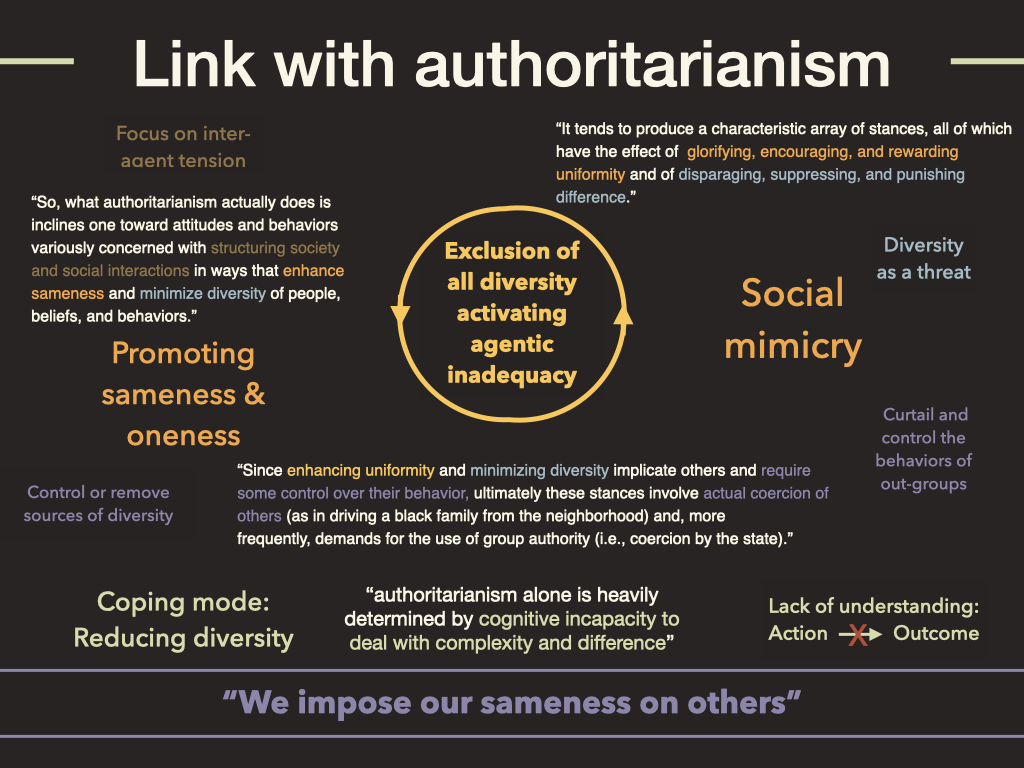
What we have been describing for a general living agent manifests within humanity as “authoritarianism”. And particularly as conceptualized by Karen Stenner in her 2005 book “The Authoritarian dynamic”.
In fact our narrative provides a first principles derivation of the defining features of authoritarianism
Stenner writes:
So, what authoritarianism actually does is [it] inclines one toward attitudes and behaviors variously concerned with structuring society and social interactions in ways that enhance sameness and minimize diversity of people, beliefs, and behaviors.
This refers to “promoting sameness & oneness” and “inter-agent tension reduction”. Stenner continues:
It tends to produce a characteristic array of stances, all of which have the effect of glorifying, encouraging, and rewarding uniformity and of disparaging, suppressing, and punishing difference.
This suggest “social mimicry” as the driver of uniformity. And it indicates that “diversity is a threat”.
In addition:
Since enhancing uniformity and minimizing diversity implicate others and require some control over their behavior, ultimately these stances involve actual coercion of others (as in driving a black family from the neighborhood) and, more frequently, demands for the use of group authority (i.e., coercion by the state).
This bluntly states that sources of diversity must me controlled or removed via curtailing and controlling the behaviors of out-groups.
Stenner also states that:
“authoritarianism alone is heavily determined by cognitive incapacity to deal with complexity and difference”
Which is a way to define ‘inadequacy’.
This all leads to what we refer to as the Authoritarian Motto: “We impose our (arbitrary)29 sameness on others”.

Stenner produced a simple formula to predict the strength of the intolerance to difference.
Intolerance to difference = authoritarianism x normative threat
A normative threat is threat to the normative order. And she defines that as a system of oneness and sameness that makes “us” an “us”. A single out-group enacting some other sameness is annoying, but not really a threat. A true normative threat is something that markedly erodes the in-group’s sameness and inspires in-group members to first mimic it and eventually to self-directedly improve on it.
Stenner specifically mentions authorities proving unworthy of trust and loss of societal consensus. The first leads either to a shift towards other authorities or to more self-direction. The loss of social consensus leads to a more complex world.
To determine whether individuals act as authoritarian or as self-director, Stenner used 5 simple two-option questions about how children should act .
| Children should: | Children should: |
|---|---|
| Obey parents | Be responsible for their actions |
| Have good manners | Have good sense and sound judgement |
| Be neat and clean | Be interested in how and why things happen |
| Have respect for elders | Think for themselves |
| Follow the rules | Follow their own conscience |
The options on the left correspond to an external locus of control and exhibit social mimicry. The options on the right correspond to an internal locus of control and self-direction. Individuals how scored high on the left options are classified as authoritarian.
To an authoritarian a normative threat is anything that self-empowers other agents to mimic less and self-decide more since this leads to a crumbling of the sameness and oneness designed to evade confrontation with one’s inadequacy.
In the absence of normative threats, authoritarians are not intolerant to diversity; a perceived normative threat changes this immediately into an in-group level digust reaction.
A summary of much of the previous is that coping dominance is activated by by a combination of inadequacy and the threat of increased habitat complexity. Typical threats are highly visible self-deciding co-creators – adequate individuals – who inspire and empower others with more effective and more realistic ideas, insights, and activities that benefit the habitat on the short and long term in ways that elude the inadequate.

The group-level disgust reaction is in characteristic response to a normative threat that is experienced as a threat to self.
Specifically a group-level disgust reaction a strong self-protective immediate reaction to purge the group from an effect felt to be toxic.
This is a rich description that points towards the main features of the associated decision-making.
This breakdown of the definition of group-level disgust points to the key features the in-group behavior selection:
The target is isolated, de-individualized, and perceived as a valueless threat The target is confronted with two options.
The first option is “We impose our sameness on you”. And the second **“We strip you of your agency”. Options corresponds to adapt, option 2 to or leave or die.
The first option is that the target recants and passes through a humiliating procedure in which it has to denounce its diversity, its individuality, and proof its in-group worthiness30. This option purges the diversity and restores oneness.
When the target is sufficiently self-directed and refuses to be brought down to the demanded sameness, restoration of oneness is impossible. The focus then moves to purging the target.
The way the target understands the habitat and and can engage in skilled behavior represents toxicity. Contact with the target’s point of view must be minimized at all costs. As a toxic influence, the target is valueless, hence no harm is done even if the target is hurt or killed. This restores in-groups sameness.
Much of the background has been published in “Cognition from life” (Andringa et al., 2015), “The Evolution of Soundscape Appraisal Through Enactive Cognition” (van den Bosch et al., 2019), and “Coping and Co-creation: One Attempt and One Route to Well-Being. Part 1 & 2” (Andringa & Denham, 2021). Links to the files in the /basics section ↩︎
Psychology tends to produce a rich and detailed description of the diversity of human behavior. Where psychology provides the ‘what’, core cognition aims to explain ‘why’ these cognitive phenomena exist and ‘why’ they have the properties they exhibit. ↩︎
Fredrickson’s Broaden and Build Theory describes this difference as underlying negative and positive emotions. For example, happiness is a goalless progression of favorable states. It expresses high co-creation and high coping skills. ↩︎
We have described this process in detail for the appraisal of the sonic environment in Table 1 and Figure 4 of van den Bosch et al. (2019) ↩︎
For woke readers who managed to come this far: because adequacy is defined in relation to real-world effectivity, it is completely independent of whether you identify as a particular species, race, or gender, or whether you decide that your skills, ideology, or outlook of the world are effective. Your (in)adequacy is solely determined by the average effectivity of real-world interactions: whether or not your behaviors realize intended outcomes. ↩︎
A more complete development of these behavioral ontologies is available in Andringa&Denham (2021), which is also presented in the /basics section and in summary in Two contrasting ontologies. ↩︎
In Psychology Barbara Fredrickson addressed the Role of positive emotions in What good are positive emotions in what became The Broaden and Build theory. ↩︎
Physicist would measure this interns of entropy: a measure of the number of states the habitat can be in. However a habitat, even a very complex one, is not in any of all possible random states, as a gas of a given temperature would be. Rather the habitat is in any of many highly unlikely (hence unstable) beneficial states that can only be reached through the skilled participation of its comprising agents. ↩︎
This characteristic of coping is via a very powerful phenomenon that we refer to as closing the system and that leads to highly predictable, and for that reason highly useful artifacts such as computers. Probably a very similar “closing the system” processes let to the evolutionary development of multi-cellular tissues and individual. ↩︎
See for example Miron (2006) ↩︎
In physical terms this corresponds to a reduction of the number of the degrees of freedom, an entropy reduction in the habitat, and a reduction of temperature. Co-creation is “hotter” than coping. Copers prefer a reduction of temperature. ↩︎
This is similar to the transition from free-flowing water to crystalline ice (ice can still flow, albeit much slower and in response to much higher pressures). Another temperature dependent phase transition is associated with the Curie temperature of ferromagnetic metals. These metals can only be magnetized below their Curie temperature. Mass formation is a special group-level phenomena that occurs only due to a reduction of the degrees of freedom (temperature). ↩︎
In modern parlance these could be called ‘influencers’. ↩︎
In social justice jargon this would be referred to as ‘privilege’. ↩︎
This might be the reason who media control is key to oligarchic control. ↩︎
Soviet citizens referred to these as apparatchiks. ↩︎
Many so-called political analysts demonstrate this feature blatantly obviously by failing to represent the position of some out-group and basing their “analysis” solely on the in-groups understanding of the out-group. The result makes full sense to the in-group, but is a waste of words in terms of realism. ↩︎
Wars, globalization, and mergers & acquisitions in business are examples of this. Unipolar global governance and monopolies are the natural end-points of enlarging the in-group. ↩︎
In humans this is for example expressed as rules, norms, laws, standards, procedures, propaganda, ideologies, advertising, career-paths, and the associated infrastructure such as law enforcement, media, and schools systems to ensure that most individuals end up contributing to “oneness and sameness”. ↩︎
In our societies this is implemented as the security state: intelligence agencies, security forces, and internal propaganda outlets. ↩︎
This is why authorities in extreme circumstances turn their diversity suppression to the own in-group (as with the Jacobins and Stalin’s Great Purge). ↩︎
Imperial overstretch is the tendency of all empires to grow beyond its sustainability limits so that at some point in time the military and other infrastructure for further growth becomes detrimental to the existence of the empire. ↩︎
“… it seems that the bureaucratic form of organization stultifies the functioning of highly autonomous and motivated employees, while it actually provides the less autonomous employees guidance and effectiveness in roles in which they would otherwise not be able to function.” (Andringa, 2013, p225) ↩︎
It is a bit more complicated than this. We (Van den Bosch et al., 2018) wrote a paper the appraisal of the sonic environment that outlines appraisal in more detail (Figure 4 and Table 1). ↩︎
Initially the shape of the habitat-wide in-group is more a sponge or Swiss cheese than a coherent block. The co-creators are still active in the holes. ↩︎
In the movie Brasil the only capable technician who makes unsanctioned repairs in a dysfunctional bureaucracy is treated a “terrorist”. ↩︎
Humans have concurrent coping and co-creation abilities, even when coping is dominant, co-creation logic is perceived. Co-creation examples balance the drive for further coping and can hence block further societal degradation. ↩︎
This is actually a definition of out-groups: an out-group is any agent (or group) whose behavior is not understood. ↩︎
The reason to stress the arbitrary nature of the “sameness” is that it is rooted in complexity reduction and not in the realization of broad benefits. The structures of co-creation (usually only dynamically stable through continual care of self-directed co-creators) are rare beneficial states in a possibility space that is vastly bigger than the simplified and impoverished state-space of sameness and oneness that offer only the benefit of low complexity. ↩︎
A fascinating example of such a humiliating procedure (ceremony almost) was recorded in during the Evergreen events in 2018 that led to the purging of Brett and Heather Weinstein. Embarking on the canoe towards equity stands for the reduction of diversity. Some individuals had to ask for permission for boarding the canoe by pledging their loyalty to the equity goals and denouncing their uniqueness. https://youtu.be/FH2WeWgcSMk?t=858 ↩︎

This paper argues for a very visible role of mentally healthy individuals in education. Only these can show children and adolescents what levels of self-development, autonomy, happiness, and growth they can in principle achieve.
Authors: Tjeerd C. Andringa
This paper is about the highest form of mental health attainable: self-actualization. It is not a repetition of what Maslow has said about the topic. Quite on the contrary; it is a more or less independent derivation of the concept of complete mental health and full mental development that validates all Maslow’s insights while providing a scientific foundation.
Maslow was spot on with his description of self-actualization, but he derived this via an intuitive process of little scientific rigor. Most scientific breakthroughs start this way. This paper is an serious, but fairly accessible, underpinning of his intuitions.
I’m not a psychologist. I’m a systems thinker. In particular, I study systems that take responsibility for their own continued existence: living agents. Agents who are very good at that self-actualize. And they prove that through tell-tale characteristics of flourishing. For me self-actualization is not at all a human specific property. In fact, modern humans might not even be very good at it, since many are rather languishing or suffering than flourishing (Keyes, 2005).
In previous papers I have described the demands of survival and flourishing in abstract and general terms that I refer to as core cognition. Core cognition is the cognition that, we postulate, is shared by all of life. With core cognition we derived the requirements of optimal agentic behavior from first principles (Andringa et al., 2015) and with that we can derive the foundations of much of (human) cognition. This gives me a broadly informed and often unique perspective on self-actualization.
In a two-part paper (Andringa & Denham, 2021; Denham & Andringa, 2021, here the combined pdf) we derived the structure of identity from first principles (namely the defining properties of life) and we have also demonstrated that some good intentioned efforts to improve society and its members are doomed to end in a state of pathological normality that is far from self-actualization.
Before that, we (Andringa et al, 2015, pdf) derived 1) the basis for the differences between the brain hemispheres, 2) why the brain has and needs two complementary systems, 3) how power and intelligence serve to prevent an ill-understood world from spinning out of control while understanding and wisdom allow the co-creation of a world in which most problem are prevented. 4) how unicellular cooperation rules explain value differences between US liberals and conservatives, and 5) why positive emotions are the basis for personal and mental growth.
In an older paper on open-ended development called “learning autonomy” (Andringa et al., 2013, pdf) we had laid much of the groundwork by identifying two modes of thought: what we now refer to as coping and co-creation. Using Escher’s tessellation “Liberation”, we showed that coping was actually described by Abraham Maslow as deficiency cognition (D-cognition).
In that paper we described it as cognition for control, certainty, and order since its aim is to realize or restore more manageable conditions to live in (which it may or may not be realistic). We also identified a complementary mode of cognition: cognition for exploration, disorder, possibility, which we now refer to as co-creation. Again Maslow had already described this as being cognition (D-cognition) and he had identified that as the characteristic cognition of self-actualizers.
D-cognition/coping is always associated with a perceived lack of safety and an associated fear of not being able to cope with the situation: it is activated by problems. At the basis, coping aims to realize a less complex world and hence it relies on the various manifestations of social mimicry that all promote oneness and sameness.
Social mimicry can be simple copying of seemingly successful, authoritative or charismatic individuals, but it can also be more indirect via adherence to norms, customs, traditions, rules, checklists, role-models, procedures, ideologies, and laws.
Individuals who express coping do so from a deep and strong (yet mostly unconscious) anxiety to retain or regain control over their lives by imposing a sharable (averaged, static, abstract, predictable) order on the behaviors of self and others. The coping mode’s social motto is: “We are right and you have to adapt your behavior to match ours.” We call this the authoritarian motto.
It is strongly related to Stenner’s (2005) Authoritarian Dynamic: “Intolerance to diversity = authoritarianism x threat level”. Where authoritarianism is a measure of reliance on coping. So the authoritarian dynamic says that the more individuals (and groups) rely on coping and the higher the threat level, the more intolerant to diversity they become.
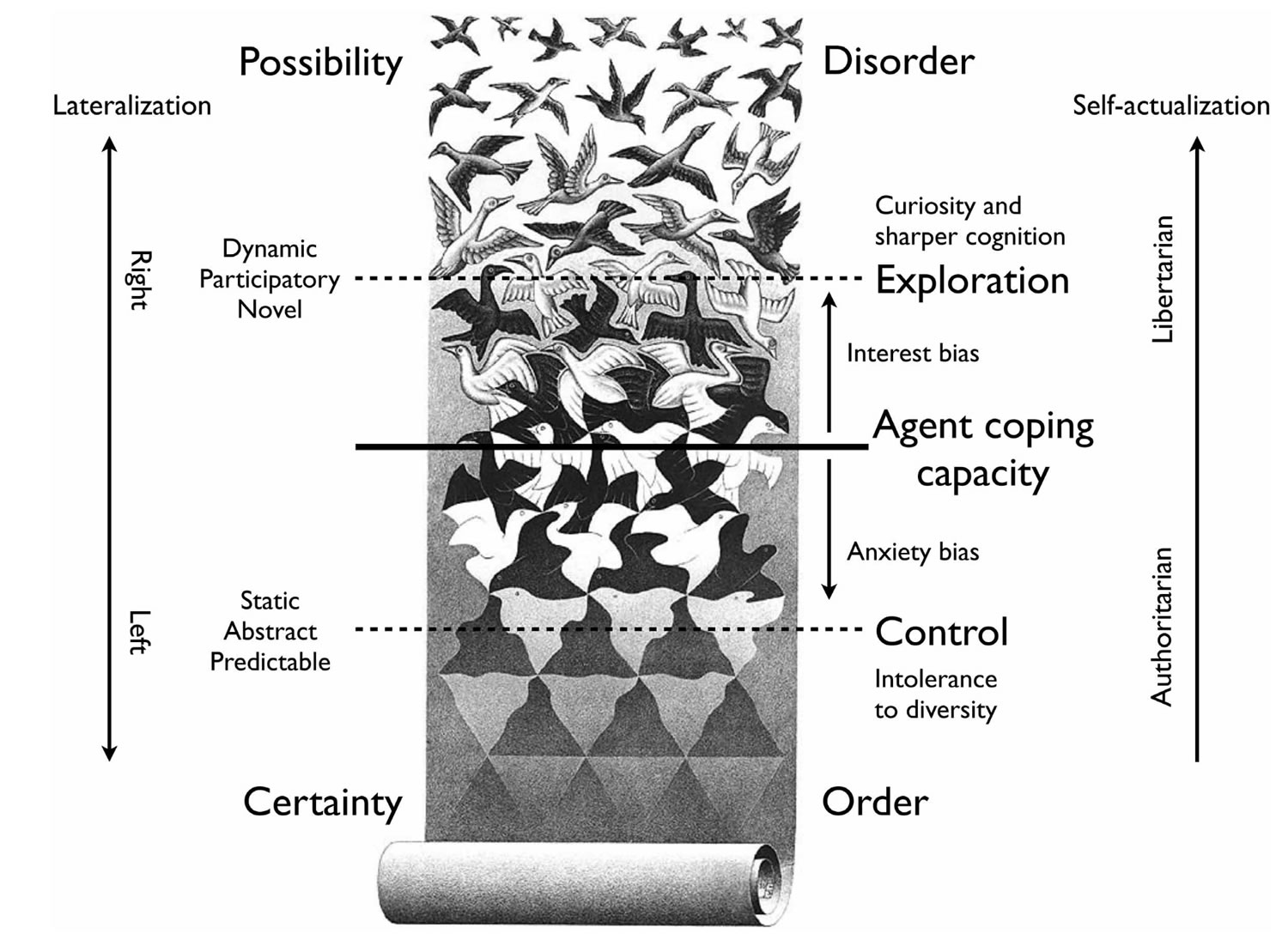
The complementarity of cognition for control, order, certainty and cognition for exploration, disorder, possibility. From Andringa et al (2013) . (M.C. Escher’s ‘Liberation’ © 2013 The M.C. Escher Company—the Netherlands. All rights reserved. Used by permission.
B-cognition/co-creation complements coping through using the possibilities of the world to add value to the habitat. Where coping aims to solve or otherwise address or suppress problems in standardized or concerted efforts, co-creation success entails the self-directed prevention of problems by reducing barriers to optimal functioning or by finding new ways to realize even better quality of life. We identified the associated continual optimization process as “pervasive optimization”: optimizing everything in the context of everything else.
Unlike coping that has specific success states – satisfied or mitigated deficiencies, and more sameness and oneness – co-creation has no definite success states. There are countless ways to realize high quality of life and there is no simple metric to favor one above the other. Where coping relies on social mimicry and the associated reduction of behavioral diversity, co-creation depends on countless self-initiated and unscripted contributions to the world that both increase diversity and quality of life.
We argued that this description of co-creation pertains to all of life and in fact drove the growth of the biosphere in the last 3.8 billion years (Andringa et al, 2015). This is self-actualization on a biosphere level. In fact the biosphere can be interpreted as “Life self-actualizing”.
While Maslow clearly indicated that being-cognition required deficiency-needs to be sufficiently satisfied, he did not say much about the interplay between being-cognition and deficiency cognition. The interplay was in part elucidated by Iain McGilchrist in his book “The master and his emissary” (2010) that describes the two complementary outlooks-to-the-the-world of our two brain hemispheres.
His extremely rich and detailed description of these two outlooks (see table 2 of Andringa et al. 2013) is yet another manifestation of the complementarity of d-cognition/coping and b-cognition/co-creation and he connects this to culture and philosophy.
McGilchrist describes the right hemisphere as the master who tasks the left hemisphere, the emissary, with specific assignments. Problems arise when the emissary, with its characteristic narrow-minded focus, high urgency, and minimal self-reflective abilities takes the master’s role. McGilchrist blames many of society’s problems, backed-up with many historical examples, on the left hemisphere (LH) taking control over matters it is much less competent at than a well-functioning right hemisphere (RH).
We proposed that co-creation (RM) is the natural default mode that is activated in the absence of perceived pressing problems (Andringa et a., 2015; Andringa and Denham, 2021). The coping mode is activated when a situation is deemed problematic (or more generally, benefits from problem solving or focus on detail).
Successful co-creation means prevented pressing problems and flourishing. Its failure leads to unprevented pressing problems. Likewise, successful coping leads to solved problems, while unsuccessful problem solving to perpetuated or new problems. Life success requires therefore both high co-creation skills to prevent problems and high coping skills to address and solve the problems that could not be prevented.
In general low co-creation skills lead to many unprevented problems and low coping skills lead to unsolved or new problems. We refer to an (in part) self-perpetuated situation of continued problems – that keep activating the coping mode – as a coping trap. This is one state of (deeply) suboptimal mental health.
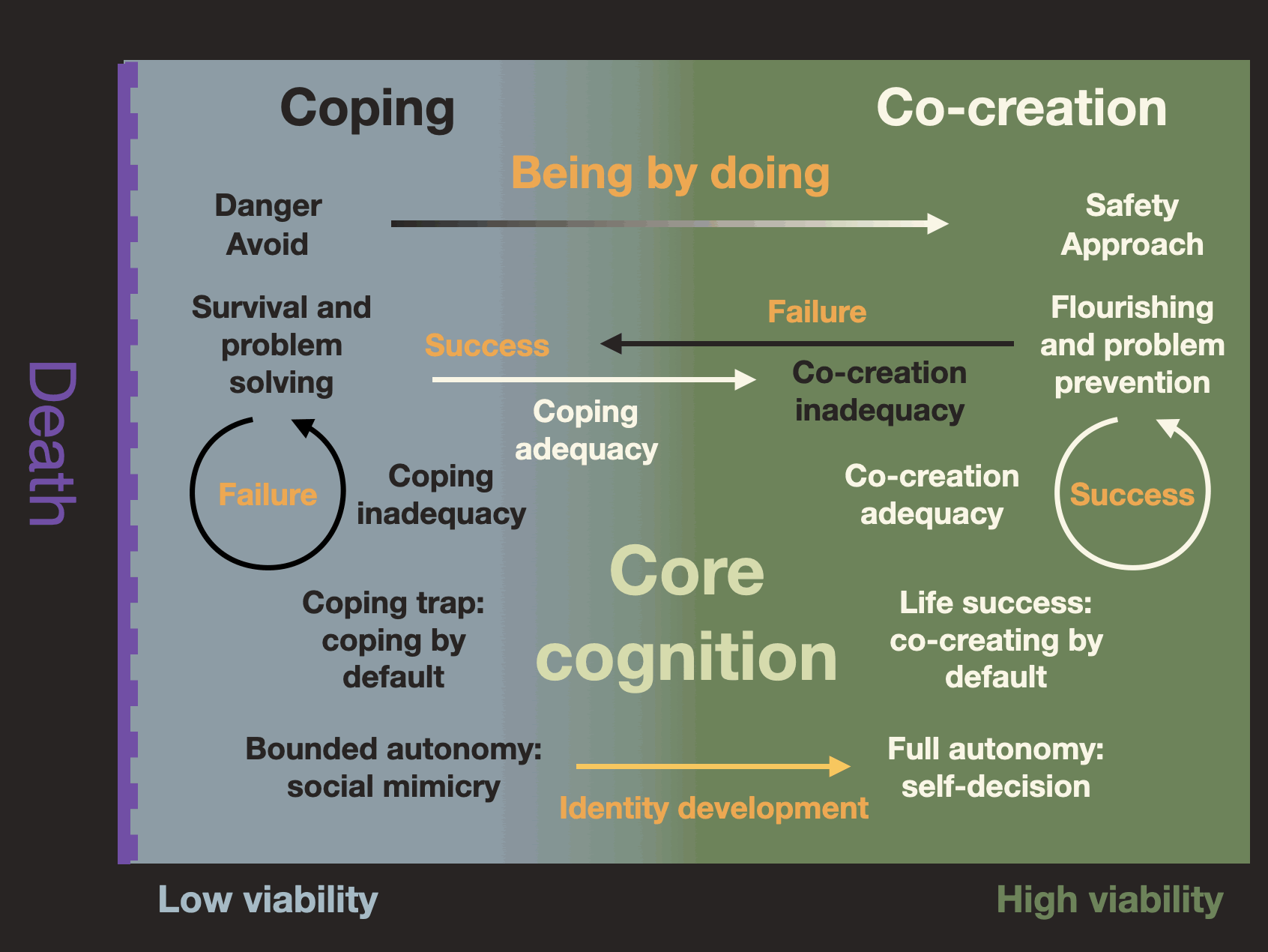
Key dynamics of core cognition. Concepts in white help to realize and protect high viability and are associated with self-avtualization. Concepts in black pertain to coping
The World Health Organization’s’ formulated ‘health’ in 1948 as ‘ A state of complete physical, mental and social well-being and not merely the absence of disease or infirmity ’. Huber (2011) introduced a new concept of health as ‘ The ability to adapt and to self-manage, in the face of social, physical and emotional challenges ’. Huber’s definition focuses on autonomy: if you are able to face social, physical and emotional challenges, then you are healthy, even in the presence of clear symptoms like obesity, anxiety, or an amputation. On the other hand the WHO’s definition demands complete physical, mental, social wellbeing, well above the level of absence of symptoms.
Maslow’s definition of self-actualization as complete mental health is a combination of the key features of both: it is “complete mental and social wellbeing through the ability to adapt and self-manage in the face of social and emotional challenges”. Complete mental health is self-generated and self-maintained and expresses the skills to prevent most problems and effectively solve or otherwise address those that cannot be prevented.
A completely mentally healthy individual expresses being-cognition and co-creation adequacy most of the time and especially to guide long-term or strategic behaviors. Deficiency-cognition and coping is expressed only as short and effective temporary fallback. Self-actualizers therefore successfully maximize the fraction of their life-time co-creating.
This also dovetails with DiPaolo’s (2014) definition of cognitivity. He writes “A system is cognitive when its behavior is governed by the norm of the system’s own continued existence and flourishing”. The more a cognitive system flourishes, the higher its viability, the further it is from death, the less it is restrained by problems, the more it co-creates and expresses being-cognition, and the more it self-actualizes.

Because self-actualization describes complete mental health, it is a health extreme: only a minority (a few percent, depending on the strictness of the definition) of the population manifests and expresses a dominance of co-creation in combination with very effective coping. Formulated like this self-actualization is the skill to prevent most problems and effectively solve or otherwise address those that cannot be prevented.
Skilled actors realize intended and beneficial outcomes, the unskilled do not or even cause harm. Skillful behavior proves proves a high congruence between intention and outcome and hence realistic expectations. Self-actualizers are very skilled in living and hence prove in the vast majority of their actions they generated realistic expectations: they have created a realistic worldview.
Physical reality, for all its intricacies and complications, is completely self-consistent: physical reality is always in states that follow strictly causally from previous states. This makes physical predictable. This predictability is the key prerequisite of skilled behavior and knowledge in general. Living agents base their very existence on the causal nature of reality.
The more pervasively one can predict the outcomes of one’s interactions with the world, the more often these work out as intended. This is what we refer to as a realistic world-view: a resource to generate realistic expectations of interaction with the full breadth of reality. A highly realistic world-view both characterizes and enables self-actualization. And self-actualizers have created that in a uniquely individual process.
In Learning Autonomy (Andringa et al., 2013) we described three phases of which the third depends on the successful mastering of phase 2. In phase 1 the agent learns to master the body. Phase 2 aims to make the mind into a reliable tool. Preconditioned on success in phase 2, phase 3 aims to effectively co-create a highly viable interaction between habitat and self. Phase 2 involves the acquisition the huge body of shared knowledge about the physical, the living, and the cultural world that we derive typically from all forms of social mimicking.
Only if this body of knowledge is sufficiently functional and broadly applicable, one can start to rely on it to engage in truly self-directed endeavors. So only when self-direction provides a net benefit, individuals have access to phase 3: the phase of self-actualization and full human autonomy. We provided a lot of converging evidence for this.
The problem with phase 2 knowledge is that it involves the adoption of shared and consensually adopted knowledge from teachers and peers, a process that Maslow calls enculturation. Knowledge acquired this way is mostly correct and functional and its application is effective in the Pareto sense: you can derive say 80% of the benefit by acquiring this knowledge, but to reach optimal or even correct results you need additional experience to refine the knowledge and to apply it safely in realistic contexts.
This refinement is not only a process that takes considerably longer, it is also a strictly private mental process: one in which you have to learn to trust your mental refinement abilities. And while you learn to trust your own decision and sense making, you develop your own unique and better than average worldview. If you do not, you have to fall back to a mostly consensual shared worldview with lower effectiveness.
This “switch” from shared, explicit and consensual knowledge to ever more individual, implicit, and self-constructed knowledge determines phase 2 success and gives access to phase 3 and (potential) self-actualization. In McGilchrist’s terminology this corresponds to a shift from left hemispheric dominance to a gradually more prominent role of the right hemisphere and, self-actualization to its dominance.
It also corresponds to a change from memorization via social mimicry, characteristic of coping, to the self-construction of knowledge (on a basis of shared knowledge) and self-direction. It is a switch from cognition for control, order, certainty, and utility to cognition for exploration, disorder, possibility, and engagement. And it is also a switch from reliance on external authority to self-direction (the internalization of the authority role).
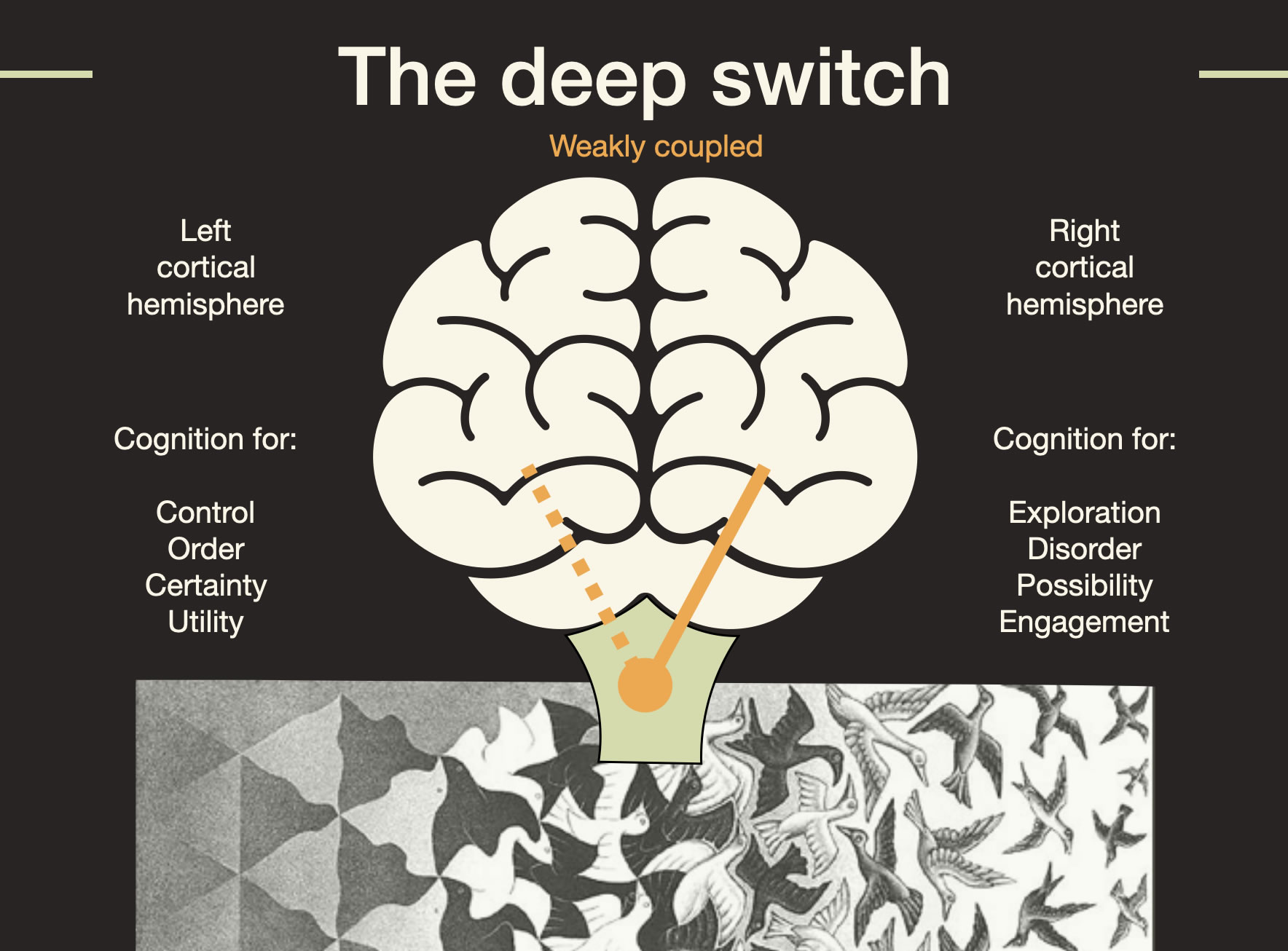
The deep switch" caption=“The deep switch signifies the gradually growing reliance on self-constructed knowledge and strategies that at the same time signifies a change from cognition for control, order, certainty, and utility via social mimicry to cognition for exploration, disorder, possibility, and self-guided engagement via the self-construction of knowledge and strategies.
This “deep switch” is a precondition for self-actualization and full mental health. Without making the switch you are limited to the domain of shared consensual knowledge. Depending on the quality of the contributions to the shared knowledge domain its quality can range from totally dysfunctional and toxic to fairly reliable and empowering.
In fact the historian Quigley (1961) claims that the statement “Truth unfolds through a communal process” lies at the foundation of Western culture. Western society has indeed created much valuable knowledge. It also created a lot of knowledge, data, and opinions of questionable utility and unrealistic and unproductive nonsense. These pollute the shared societal narrative and degrade its utility and reliability. Of course, the more dysfunctional the shared narrative, the more difficult it will be to protect against the adoption of disempowering data, ideas, and opinions. I refer to the process of getting rid of this as weeding out toxic enculturation.
Phase 2 depends by and large on copying the behaviors, ideas, strategies, opinions, and talking-points of others: social mimicry. If successful, this is a stepping stone towards the more advanced behaviors in phase 3. For this aspiring self-actualizers need to learn the mental habits to weed ’toxic enculturation’ because this causes or prolongs problems when relied on and effectively reduces the life-fraction co-creating. And with that it reduces one’s autonomy hence locks one in phase 2.
Self-actualizers prove they succeeded in weeding out the knowledge items and inconsistencies in their worldview with a dominant co-creation mode. Non-self-actualizers suffer from toxic knowledge items and a generally inconsistent world-view that prevent them to consistently reach the higher levels of self-maintained viability and locks them in the coping mode.
This is a process in which (system 2 and system 1) [bullets are draft]
This is a mind that has learned to improve his own thoughts by critical examining them. This is a well-studied and documented process,
Perry (1998), who studied epistemological development in adolescents (in his case Harvard students) has described the associated mindful engagement when he described the features of the educated mind. He wrote:
The educated mind has learned to think about even his own thoughts, it examines the way it orders his data and the assumptions it is making, it compares these with other thoughts that other people might have and adopts whatever this scrutiny of data, ideas, and opinions decides on as most reliable and productive.
In doing so the educated mind learned to think in accordance with reality from which position he can take responsibility for his own stand and negotiate – with respect – with others.
The key point here is that an educated mind self-examines data, ideas, and opinions and replaces these with ever more reliable and productive variants. This habit to make one’s data, ideas, and opinions ever more reliable and productive is not only the process that weeds out toxic enculturation in internal inconsistencies between knowledge items, it is also the driver of self-actualization.
Note that nothing in this definition requires formal education. Formal education might even impede the deep switch when learning focusses solely on the diverse forms of social mimicry (like complying with standardized learning outcomes) and the associated memorization at the cost of the self-construction of knowledge.
Weeding out unproductive and toxic knowledge items is also a characteristic of the achieved identity style. In identity research, the data, ideas, and opinions that one takes for true – one’s worldview – is referred to as self-relevant information. It is self-relevant because what we take as reliable and productive becomes part of our identity or self-theory. Identity can be defined as “a theory of me as actor in the world” or “self-theory” (Berzonsky, 1992): how you define yourself determines how you engage the world. Berzonsky (1992), writes:
The effectiveness of this identity structure or self-theory depends on its pragmatic utility: Does it enable individuals to cope successfully with the stressors and personal problems that are encountered in everyday life? As contextual demands change and new situations are encountered, continued personal effectiveness will depend on the way in which the identity structure or self-theory is revised or conserved.
Self-actualizers know that their set of self-relevant information – their worldview – can and should be improved by identifying and repairing errors, inconsistencies, and missing data and hence they welcome (high quality) information that is “dissonant” (conflicting) with their current world-view because it challenges them to reduce the conflict between their current worldview and potential improvements derived from different perspectives on reality. This find this process also quite pleasurable.
Identity research calls this the informational identity style. This attitude towards information is, as one would expect of something essential to self-actualization, predictive of many aspects of their being. Berzonsky (2011) summarizes the informational identity style as follows:
Individuals with an informational style deliberately search out, process, and evaluate self-relevant information before resolving identity conflicts and forming commitments. They are self-reflective, skeptical about their self-views, interested in learning new things about themselves, and willing to evaluate and modify their identity structure in light of dissonant feedback. Research indicates that an informational style is associated with self-insight, open-mindedness, problem-focused coping strategies, vigilant decision making, cognitive complexity, emotional autonomy, empathy, adaptive self-regulation, high commitment levels, and an achieved identity status. Individuals with high informational scores tend to define themselves in terms of personal attributes such as personal values, goals, and standards.
This description points to an aspect that has not yet been focused on: self-actualizers self-manage personal growth to meet the challenges of changing circumstances (“problem-focused coping”, “modify their identity structure”, and “adaptive self-regulation”). To do so they need to be “self-reflective, skeptical about their self-views, interested in learning new things about themselves, and willing to evaluate and modify their identity structure in light of dissonant feedback”.
Both the description of the educated mind and the informational style rely on a combination of strong co-creation and coping skills with co-creation and the associated enlargement of behavioral repertoire in the lead and coping as an effective fallback.
Self-actualizers are a subpopulation of identity achievement. Individuals with and achieved identity have experienced a period of self-exploration in which they learned to weed out toxic enculturation, where they developed and learned to trust a personal world-view that allows them to (mostly) think and act in accordance with reality.
They have skills and strategies that work reliably and hence do not have to be changed. It seems as if they have committed to particular life courses. But these commitments are not so much a deliberate choice, as a set of reliable and broadly beneficial personal strategies that they continually build on and hence value highly and protect.
The more they self-construct their personal sphere of influence, the more they prevent problems (co-creation) and the more effectively and quickly they address the ones that cannot be avoided, the more they self-actualize. An achieved identity style is indeed a prerequisite to self-actualization.
This then concludes the first part"Self-actualization: what is it?”. Self-actualization is not only near optimal mental health, it is as much a form of optimal living. And this form of optimal living is preconditioned on developing a realistic worldview.
Self-actualization has a number of tell-tale indicators.
In the next part, full mental health will become more meaningful by contrasting it with different forms of existence that fall short of it.
What self-actualizing is will become even clearer by contrasting it to behavioral patterns that are deemed quite normal – and are often the norm – and not normally indicative of sub-optimal mental health. I do this using the structure of identity as has been elucidated in the last 50 years.
Traditionally, the structure of identity development is depicted in four quadrants. The achieved identity style, including the self-actualizers, is one quadrant. The other quadrants are referred to as the moratorium, the foreclosed, and the diffusive identity style. Self-actualizers engage in characteristic mental and identity development processes. Non-self-actualizer are either:
The four quadrants arise from the interaction of two axes. One axis denotes self-exploration or not. And the second axis firm commitments or not. Self-actualizers are are committed self-explorers.
Depending on the situation (societal, social, physical, physiological) everyone can adopt strategies characteristic of each quadrant. Yet in the context of normal life, we tend to be dominated by behaviors characteristic of one of the quadrants: our identity style (Berzonsky, 1992). In addition, there is a natural life-course development towards self-exploration and commitments. This development can however stall indefinitely if for example the deep switch is avoided or never completed.
In part 2 of our recent paper (Denham & Andringa, 2021) we outlined the deep relation between coping and co-creation adequacy and the structure of identity (Denham & Andringa, 2021). We summarized this in a somewhat complicated figure centered around four strategies to deal with life’s strategies: preventing, solving, controlling, and avoiding problems. The different identity styles rely on different combinations of these, which to a large extend explains the clear differences between the identity styles.
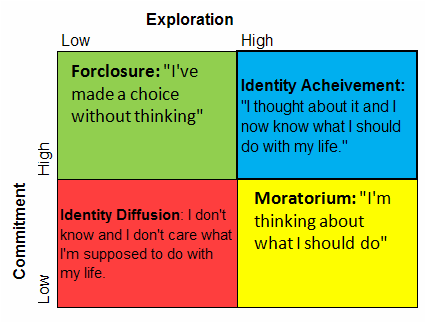
Individuals with the moratorium identity resemble achievers in many respects. Yet they differ characteristically in the absence of stable commitments. Moratoria clearly engage in self-exploration and weed out some toxic enculturation. So they clearly prefer co-creation over coping. But compared to achievers they have lower coping skills, which entails that many problems and situations are not efficiently dealt with and hence linger.
Where problems activate achievers to deal with them quickly and effectively, moratoria tend to avoid them. This makes sense given their low coping skills, but it deprives them of opportunities to develop these and assert themselves with constructive solutions. Without effective coping, they have no way to execute their strategies optimally and they cannot to protect these in times of adversity.
This makes it impossible to execute stable strategies (commit) and instead adapt to circumstances, rather that grow to match the new challenges as achievers do. As preferred co-creators they explore a lot and engage actively with the diversity of the world. Yet this barely leads to the stable life-strategies – commitments – characteristic of achievers.
In addition, low coping skills keep a background of problems active and hence the coping mode is more often active than in achievers. This holds especially in times of anxiety, trouble, and uncertainty, where they can easily fall back to one of the other identity styles.
At the same time their low coping skills make them prefer comfort and restoration even more than others because it allows them to avoid or restore from their background problems. At the same time their co-creation skills make them fairly good in preventing problems. The combination of broad co-creation skills and a lack of high effectiveness inspires them to co-create a world in which they are less likely to be confronted with their own coping inadequacies.
Moratoria are in the process of making the deep switch. They switch between co-creation and coping most clearly of all identity styles. They prefer co-creation and self-exploration, but as weak copers they are unable to quickly end the problems they are faced with. This entails that they have not yet developed the reliance on self-constructed knowledge and strategies. In easy times they do, in difficult times they fall back to coping and social mimicry; in which case they behave like foreclosures or diffusions. In this case they become intolerant to diversity and prevent the personal growth that might allow them to cope better with circumstances. This is the authoritarian dynamic (Stenner, 2005) at work.
Nevertheless, they tend to understand the basics of self-actualization and find it highly desirable. At the same time they find the path towards it quite elusive.
[This part is repetitive]
The identity style that conflicts most with self-actualization is the foreclosed identity. And that is not because they are furthest away from self-actualization (which is the diffusive identity), but because of an exclusive reliance on coping, which actively forecloses self-actualization by suppressing all ‘dissonant information’ through a near exclusive reliance on social mimicry: rule following, procedures, traditions, checklists, ideologies, authority supported narratives, and consensually derived shared knowledge,
On a group level foreclosures are effective copers, but as individuals and groups they are ineffective co-creators. Ineffective co-creation (problem prevention) in combination with unaddressed toxic enculturation entails that foreclosed individuals and their in-group live in a world of structurally unprevented problems. Their high coordinated – hence group-level – coping skills keep these problems usually at manageable levels, but this requires a constant effort to suppress undesired (read potentially unmanageable) diversity.
Because they live in a world of structurally unprevented problems, foreclosed individuals rely on coping because they continually feel a deep and strong (yet mostly unconscious) anxiety that motivated them to retain or regain control over their lives by imposing a sharable (averaged, static, abstract, predictable) order on the behaviors of self and others. Hence they apply the coping mode’s social motto: “We are right and you have to adapt your behavior to match ours.”
This fits with the key strategies of foreclosures to deal with life’s challenges: a combination of solving and suppressing problems. Promoting oneness and sameness can solve some problems, but intolerance to diversity ensures that solutions and improvements are not even considered and hence foreclosures maintain conditions far below optimal. Coping is for survival, not for flourishing.
Stenner (2005) calls potentially undesired diversity a ’normative threat’: a threat to the normative order and the cohesion and proper functioning of the in-group. Foreclosed individuals insist on “oneness and sameness” in all strategies, opinions, data, habits, traditions, narratives, and beliefs on which the proper functioning of their in-group relies on. This insistence is not a polite wish, but an existential need since they simply no longer have the cognitive apparatus to deal with more effective and productive strategies that conflict with the in-group narrative.
And because of this, they tend to restore – individually, but typically in groups – in-group oneness and sameness first lovingly and if necessary ruthlessly. Any in-group, small or big, whether a cult, ideology, religion, political or sexual orientation, knowledge discipline, nation, cultural or informational subculture, profession, or knowledge bubble, that functions according the logic of coping, promotes sameness and oneness by first identifying and later suppressing dissonant out-group influences. Even the main culture of a region can behave like this.
For foreclosures, commitments are the direct result of excluding out-group options and hence they have no choice other than to act in accordance with the worldview of their in-group. For foreclosures commitments are just expressions of the full and unchanged adoption of the in-group narrative and not of any true self-direction.
So they can commit to a certain in-group carrier path, in which one could them ambitious. And they try to be the best in-group member they can be. But this almost inevitably entails sacrificing individual needs. Burn-outs seem to be a typical manifestation of this when the brainstem, tasked with keeping the body functional, no longer accepts this neglect and shuts down all motivation to continue the neglect.
Individuals with a foreclosed identity have never engaged in serious and successful self-exploration, because they unquestionably adopted the norms, practices, and narratives of the in-group that they are committed members of. They are fully enculturated in-group members who prevent themselves from weeding out the toxic cultural influences of their in-group. Because because if they so that would make them flawed in-group members.
Hence they not only self-censor urges and ideas that conflict with the shared narrative, they also insist that others do so. This entails that with respect to the core narrative of the in-group they tend to be fairly interchangeable, predictable, and de-individualized. This is social mimicry successfully leading to more sameness and oneness. Whatever diversity exists does not conflict with the shared in-group narrative.
The term foreclosed {to rule out or prevent] is actually well chosen. They have not only prevented self-exploration through the mindless adoption of some in-group narrative, but they actively rule out and suppress many perfectly feasible improvements to self, group functioning, and the world if these do not fit in their ideology, narrative, or creed. They implement the authoritarians motto: “We are right and you have to adapt your behavior to match ours”. And Stenner’s (2005) Authoritarian Dynamic in the sense that their intolerance to diversity scales with the normative threat-level they perceive.
Associated with the foreclosed identity comes a specific attitude to information that is referred to as the normative identity style. Berzonsky (2011) describes this normative orientation as follows.
Individuals with a normative orientation internalize and adhere to goals, values, and prescriptions appropriated from significant others and referent groups [in-groups] in a relatively automatic or mindless manner, that is, they make premature commitments without critical evaluation and deliberation. They have a low tolerance for ambiguity and a high need to maintain structure and cognitive closure. Individuals who adopt this protectionist approach function as dogmatic self-theorists whose primary goal is to conserve and maintain self-views and to guard against information that may threaten their “hard core” values and beliefs. This relatively automatic approach to self-construction is associated with a foreclosed identity status and should lead to a rigidly organized self-theory composed of change-resistant self-constructs. A normative orientation is associated with firm goals, commitments, and a definite sense of purpose, but a low tolerance for uncertainty and a strong desire for structure.
Which all fits perfectly with the cognition for certainly, order, and control that we defined earlier. The a priori exclusion of dissonant out-group ideas in combination with a existential dependence on oneness and sameness entails that the shared narrative that unifies the in-group has few options to weed out unproductive, unreliable, or even toxic aspects.
In practice this entails that although the foreclosed individuals express full faith in the veracity of the shared narrative, ideology, or creed, there is no reason to assume that the veracity is any better or less dysfunctional that other in-group narratives. The focus on in-group sameness and oneness prevents that.
Bonhoeffer‘s Theory of Stupidity
[At some point a table with a ]
The fourth and last identity is referred to a as identity diffusion. This is the group of individuals with neither effective coping nor co-creation skills. Like foreclosures they avoided self-exploration (they very well know they might not like what they will find when they do). And like moratoria they avoid problems and hence miss opportunities to learn problem solution skills. As a consequence, diffusions live in a world of unprevented and unsolved problems that they perpetuate habitually. And without these skills and a clear self-theory they respond more than they plan and they have to explain their actions using an ad hoc theory that changes with the circumstances. They therefore show no commitments.
[Self-reflection, they do not like when they reflect, avoid it hence learn little from from their tribulations: search for guidance, guru’s, spiritual leaders, idols, role-models, to mimic. ]
Unlike foreclosed individuals who are effective in-group members, they try to fit in via all types of social mimicry, but often fail to do so with sufficient benefits to self. For example they might crave likes on social media, but dread the prospect of not receiving them. Since they do barely understand the world they live in, they cannot predict the consequences of their own actions and are often confronted with unexpected and unexplainable side-effects (that nevertheless receive some ad hoc explanation). Deep inside they know that they play a big part in perpetuation of their own problems and hence they have great difficulty in engaging in all that is not habitual. This manifests as procrastination, which eventually entails that circumstances rather than their own initiative decide on their life-course.
Yet despite this all,
Because the live in a world of unprevented and unsolved problems (a coping trap) they rey
A diffuse-avoidant orientation involves a reluctance to confront and deal with identity conflicts and issues. If one procrastinates too long, actions and choices will be determined by situational demands and consequences. Such context-sensitive adjustments, however, are more likely to involve transient acts of behavioral or verbal compliance rather than stable, long-term structural revisions in the self-theory. This processing orientation, originally identified as a diffuse orientation is postulated to be typical of individuals categorized as having a diffused identity status. When it became apparent that at least some strategic avoidance was involved, it was referred to as the diffuse/avoidant (confused and/or strategic) orientation. The term diffuse-avoidant (with a dash instead of a slash) currently is preferred because it denotes that the orientation involves more than a confused or fragmented self; it reflects strategic attempts to evade, or at least obscure, potentially negative self diagnostic information. Individuals with a diffuse-avoidant orientation adopt an ad hoc, situation-specific approach to self-theorizing, which should lead to a fragmented set of self-constructs with limited overall unity. They assume a present-oriented, self-serving perspective that highlights immediate rewards and social concerns, such as popularity and impressions tailored for others, when making choices and interpreting events. Diffuse-avoidance is positively associated with efforts to excuse or rationalize negative performances, self-handicapping behaviors, impression management, limited commitment, and an external locus of control.
“I’m dysfunctional and I am convinced that if the whole world changes to accommodate my dysfunctionality that I do not suffer from my dysfunction”
Andringa, T. C., & Angyal, N. (2019). The nature of wisdom: people’s connection to nature reflects a deep understanding of life. Psychology. Journal of the Higher School of Economics, 16(1), 108–126. https://doi.org/10.17323/1813-8918-2019-1-108-126
Andringa, T. C., Bosch, K. A. M. van den, & Vlaskamp, C. (2013). Learning autonomy in two or three steps: linking open-ended development, authority, and agency to motivation. Frontiers in Psychology, 4, 18. https://doi.org/10.3389/fpsyg.2013.00766
Andringa, T. C., Bosch, K. A. M. van den, & Wijermans, N. (2015). Cognition from life: the two modes of cognition that underlie moral behavior. Frontiers in Psychology, 6(362), 1–18. https://doi.org/10.3389/fpsyg.2015.00362
Andringa, T. C., & Denham, F. C. (2021a). Coping and Co-creation: One Attempt and One Route to Well-Being. Part 1. Conceptual Framework. Psychology in Russia: State of the Art, 14(2), 152–170. https://doi.org/10.11621/pir.2021.0210
Berzonsky, M. D. (1992). Identity Style and Coping Strategies. Journal of Personality, 60(4), 771–788. https://doi.org/10.1111/j.1467-6494.1992.tb00273.x
Berzonsky, M. D. (2011). Handbook of Identity Theory and Research. 55–76. https://doi.org/10.1007/978-1-4419-7988-9_3
Denham, F. C., & Andringa, T. C. (2021). Coping and Co-creation: One Attempt and One Route to Well-being. Part 2. Application to Identity and Social Well-being. Psychology in Russia: State of the Art, 14(3), 217–243. https://doi.org/10.11621/pir.2021.0314
Paolo, E. A. D., & Thompson, Evan. (2014). The Enactive Approach (L. Shapiro, Ed.; London; pp. 1–14). The Routledge Handbook of Embodied Cognition.
McGilchrist, I. (2010). The master and his emissary : the divided brain and the making of the Western world (New Haven, Conn.). Yale University Press. http://scholar.google.com/scholar?q=related:jEFLCk-_psUJ:scholar.google.com/&hl=en&num=30&as_sdt=0,5
Keyes, C. L. M. (2005). Mental Illness and/or Mental Health? Investigating Axioms of the Complete State Model of Health. Journal of Consulting and Clinical Psychology, 73(3), 539–548. https://doi.org/10.1037/0022-006x.73.3.539
Perry, W. G. (1998). Forms of Ethical and Intellectual Development in the College Years. Jossey-Bass.
Stenner, K. (2005). The authoritarian dynamic (New York; First Edition). Cambridge University Press.